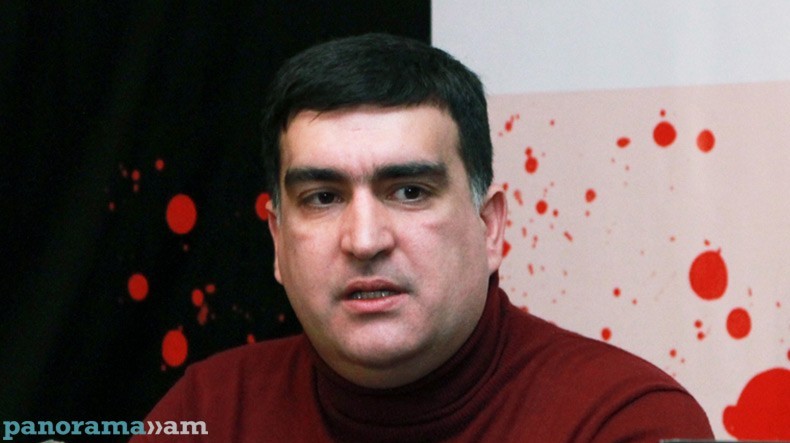
Aris Ghazinyan: Yerevan’s Blue Mosque was constructed during reign of Persian governors from Zand dynasty
The new times in Persia were connected with the sudden rise of Nader, the ataman of a gang, who was originating from the Qereqlu clan of the Afshars, a Turkic-language tribe. Son of a poor furrier from Khorasan, Nader was brave and ambitious and his thugs held the whole north-east of Persia – by that time decayed – in fear. Armenian journalist and researcher Aris Ghazinyan writes about it in his book “Yerevan: with a cross or on the cross,” which is an attempt of setting and considering an extremely diverse range of processes directly or indirectly forming the character of the development of the territory in question and predetermining the inevitability of turning Yerevan into the main centre of the Eastern Armenia, and later on into the capital of the recovered Armenian state.
Nadir successfully fought in all the directions, which motivated Shah Tahmasp II to take him into service. Taking advantage of the favourable situation, he removed Tahmasp from the throne in 1732 and “seated” the two-months-old prince Abbas III on it with his regency. Factually, this was what brought an end to the dynasty founded by Ismail Safi.
Before declaring himself Shahanshah “Tahmasp III,” Nader Kuli Bek intended to return the positions his predecessors had lost, and his main aim was to conquer Sunni countries, first of all, the Ottoman empire.
By that time, Yerevan – ruled by Rejeb Pasha, one of the Turkish commanders who had taken part in the conquest of the fortress – had been a part of the Sublime Porte.
After acceding to the administrative post, he ordered Catholicos Asdvadzadour to compile a systemised account of the entire possession of the town in order to conform the monetary circulation to the Ottoman principles of taxation.
However, the oppressed condition of Yerevan’s Armenian population under the Ottoman rule was more expressed in that there could be no mention about “autonomy” under the Ottomans, while the Ararat region had been developing more or less independently in the former era with the taxes being also used for the needs of the city.
After Catholicos Asdvadzadour’s death, Karapet II Ulnetsi succeeded him. Notably, he was elected in Constantinople rather than in Etchmiadzin. However, during his short term, the Catholicos was able to unite the monks “who were spread across dioceses” in the Ararat Plain in the period of the Ottoman rule and even decorate the socle of the Great Altar of Etchmiadzin Cathedral with the images of the twelve apostles¬ ¬¬– the works of Hakob Hovnatanyan, a prominent artist, Ghazinyan writes.
In November 1734, Catholicos Abraham II and Ali Pasha, Yerevan’s Ottoman governor, died on the same day. On the next day, Haji Huseyn Pasha was appointed as the new governor of the city, and Abraham III Kretatsi, born in Heraklion (Candia), Crete, was elected as a new Catholicos.
Next summer, the Ottoman army led by Abdulla Pasha and Mustafa Pasha was defeated not far from Yerevan. Abdulla Pasha was killed and the Turks had to surrender the city. This was when Russia stood up against the Ottoman Empire. Having the Persian regent as a powerful ally, Russia signed an agreement with Nader and gave the Caspian regions, which Peter I had seized, back to Persia. As a result of these events, Yerevan was included into Nader’s state in 1735.
Building his own empire, Nader intended to create a principally new Muslim union; that is why he viewed homagers’ national and religious backgrounds exceptionally from the angle of the benefits of his state. In the period of the military operations against the Ottoman Empire, he resettled a thousand Armenians into Khorasan to develop the crafts and trade there. Moreover, he intended to resettle Armenians into Khorasan not only from rural areas but also from Tiflis and Yerevan.
“After they left, I stayed three more days in Tiflis, for the mighty khan ordered to drive three hundred families to Khorasan from the city. He gave a similar order about the Ararat region. He ordered Yerevan’s khan, kalantar and melik, to list three hundred families upon their arrival, forcefully take them out of their homes and drive to Khorasan. A similar order also came for Tiflis. And three hundred families were listed and gathered and driven into one church. Hearing about their expulsion and about being listed, many came to the church where I stopped and sobbed, lamented, and the wail reached the sky. They cried and wailed and screamed and asked me ¬– falling on the floor – to request the khan to release them and not to exile them to foreign lands. Seeing the grief of the people, of the men and women, I, a sufferer, suffocated, my heart burned, I shed bloody tears. I beat a path to the bashaws’ doors and prayed and asked them imploring to rid the Armenians from that grief. And with the God’s mercy, the khan’s heart softened for some reason, and he left them.
They gathered 3000 tomans and 3000 somars [unit for measuring grain] of grains, paid in the money and grain and got rid of the exile. I also suffered a lot trying restlessly to save the three hundred families from the Ararat region but there was no way,” Kretatsi writes in the “Brief Narration of the Beginning of Nader Shah’s Reign.”
In 1736, Nader declared himself shahanshah and signed agreements both with Russia and with Mahmud I, the Ottoman sultan. With the agreements, the latter renounced his Caucasian lands in favour of Persia. Western Armenia remained under the Ottoman control, while the eastern part, including Yerevan, became parts of Nader’s empire, Ghazinyan writes.
With the aim of compiling a list of state taxes per cities, villages and regions, Mirza Kyazum arrived in Yerevan as a ruler. He did not hide his hatred towards the Christians, and felt especially comfortable in Armenia, where he got a particular pleasure of oppressing the Christian population. He increased the taxes and imposed them heavily on the church. If Rejeb Pasha took 1500 dinars for one vineyard, Mirza Kyazum took 9810. If the Ottoman rulers collected 1650 dinars for one mill, the sum rose to 3150 under Kyazum. If earlier 25 dinars were collected for one sheep, now it was 60, Ghazinyan notes.
Abraham III of Armenia constantly tried to draw the shah’s attention to the arbitrariness and excesses but all his written addresses remained unanswered. According to Ghazinyan, Mirza Kyazum’s numerous agents might have been catching the correspondence of the church, because after every letter, Mirza increased the taxes and read out Nadir Shah’s “answer” before the residents of the city and the dignitaries.
Nevertheless, one of the addresses somehow achieved the shah’s response, whose text suggested that the Catholicos’ earlier letters had not really reached him. Nader wrote the following to Mirza Kyazim, “When I came to Yerevan leading numerous troops, the khalifa (the Catholicos) and his people met me with gifts, rendered me great services and gave provisions to my troops. That is why I pardoned them all the taxes and make maghaf [free] everything they had so that they always remained maghaf. Knowing this, you, my servants, do not touch the mulks and the community of Etchmiadzin and include this rule into the state defter so that it remains forever.”
Later, Nader singed an order for his servants strictly banning them from going close to the lands of the church or measuring anything there, and he put his own seal on it.
In the 40s of the 18th century, Yerevan (Erivan) Khanate started to be gradually formed in the Persian Empire. Tahmasp Kuli Khan (Nader Shah) can be considered the first plenipotentiary governor of the khanate. He was conducting a loyal policy towards the local Christian population. As a result, the trade revived with Yerevan again becoming an important market. The mint, which had started producing Persian coins, called Abbases, came to function again during Nader Shah’s reign. Moreover, Nader Shah is known to have positively responded to the Catholicos’ request to coin “at least copper money if there is no silver, and also silver coins, if silver is found, in Yerevan.” Upon his request, Nader appointed Melik Hakobjan as the head of the mint.
“After the military operations between Nader Shah and the Turkish Sultan ceased, Yerevan Khan and I wrote letters to Kars, Erzerum, Tokat, Bayazet, Van, Baghesh and other places. I wrote to my people and the khan to the pasha of Kars that we had an order by Nader Shah, the great khan, to send a word to the country and inform your state that the merchants and also everyone else can now come to Yerevan Khanate and sell and buy everything they want without doubt or fear as the peace is restored,” Abraham III writes.
Remarkably, many Western Armenian families, former homagers of the Ottoman Empire, moved to a permanent residence in Yerevan.
Meanwhile, Sultan Mahmud I could not afford seeing the rise of Persia. A new war between the Ottoman Empire and Persia broke out in 1743, when Mahmud Kuli Khan was Yerevan’s governor. Notably, Nader Shah was the initiator of the war as he intended to hinder the Ottoman undertakings in the bud. In August 1745, a battle was fought near Yerevan, which ended in a complete defeat of the sultan’s army. Nader, however, was not able to take up an attack on the territory of the Western Armenia. A new treaty was signed confirming the imperishability of the former borders and Yerevan’s “Persian jurisdiction.”
After Nader’s death, a struggle for the throne broke out, and representatives of Iranian (Aryan) Zand dynasty soon took most of Persia under their control marking the Iranian dynasty’s return to the power after seven hundred years, Ghazinyan writes.
Mohammad Karim Khan, the new governor, did not take the shah’s title and was called laqab Vakil e-Ra'aayaa (Representative of the People). Meanwhile, Yerevan finally formed its borders as an administrative territorial unit of the Persian Empire in the middle of the 18th century after Nader’s death. The territory it occupied was a little smaller of that of the abolished Yerevan district (beglerbegdom) of the Safavid period, which also included the southern part of the central left bank of the river Arax together with Nakhijevan. The new administration only consisted of the northern and central parts of the Ararat Plain and reached Sharur and Sadarak in the south. Yerevan and Nakhijevan became the administrative centres of separate khanates of their names. After Nader’s death, the territory of the Southern and Eastern Transcaucasia was divided into khanates. In addition to Yerevan and Nakhijevan khanates, Karabakh, Ganja, Sheki, Shirvan, Kuba, Baku khanates and several smaller administrations were established.
After the Ottoman-Persian treaty was signed and the Zand dynasty ascended the throne in Persia, Yerevan received a chance to develop in relatively calm conditions. The period of Ottoman-Persian wars, which lasted for over two hundred years sending Yerevan from hand to hand about 15 times, ended. The trade and crafts again started to develop in the city, houses and religious buildings were reconstructed, Ghazinyan writes.
In the second half of the 18th century, Hussein Ali Khan, the governor of Yerevan, reconstructed the residence of the sardars, the palace of the khan, in the territory of Yerevan Fortress. He constructed the Blue Mosque – still preserved – 800 metres to the north-west of the walls of the fortress. The Blue Mosque occupied an area of approximately 7000 square metres and was inside a little yard (71x47 metres), which was surrounded with a brick wall. Four 25-metre-high minarets stood along its perimeter. Apart from the praying hall, the complex also included twenty-eight pavilions of various uses (library, madrasa). The cupola and the minarets were decorated with faience tiles adorned with majolica.
The mosques in Tapabash and Demir Bulagh were also reconstructed.
To be continued
Aris Ghazinyan’s “Yerevan: with a cross or on the cross” is a book about the social and political history of Yerevan and Yerevan district (as a habitat) since the declaration of Christianity to the beginning of XIX century. In addition to demonstrating historical facts based on archive documents and sources, the book also considers the fundamental theses of the Azerbaijani historiography and Pan-Turkic ideology aimed at appropriating the historical, cultural, and spiritual heritage of the Armenians and other nations of the region by falsifying their history.
Related news
- Aris Ghazinyan: Ottoman Sultan planned to pull down Etchmiadzin Cathedral to put end to everything Armenian
- Aris Ghazinyan: Every time Yerevan rose from ashes and ruins
- Aris Ghazinyan: People surviving in various districts of Biblical highland were gathering in Yerevan
- Aris Ghazinyan: Seeing Armenians’ well-ordered lands, Abbas I started working out plans of using Armenian resource in economic development of country
- Aris Ghazinyan: Timur took thousands of Armenians out of Armenia to develop crafts and trade in his empire
- Aris Ghazinyan: Yerevan became place of pilgrimage for Christians since late 13th century
- Aris Ghazinyan: Average seventh-century inhabitant of Yerevan embodied collective image of the Armenian of that time
- Aris Ghazinyan: Territory of Yerevan generates unlimited time in its limited borders
Newsfeed
Videos






























